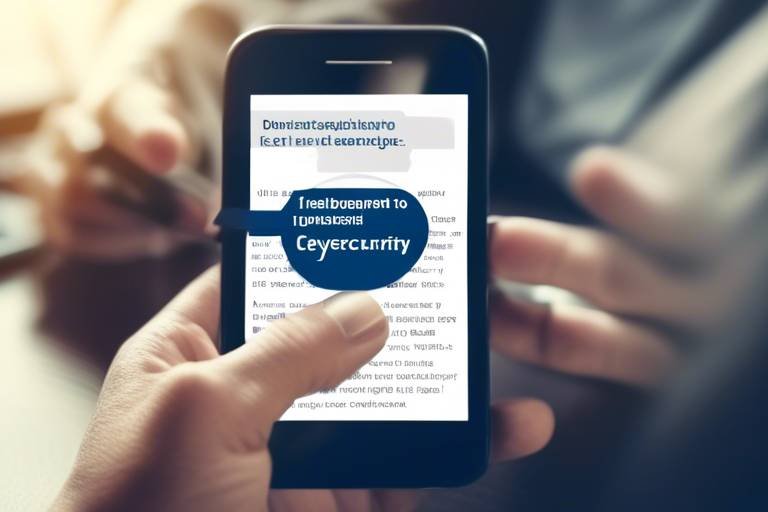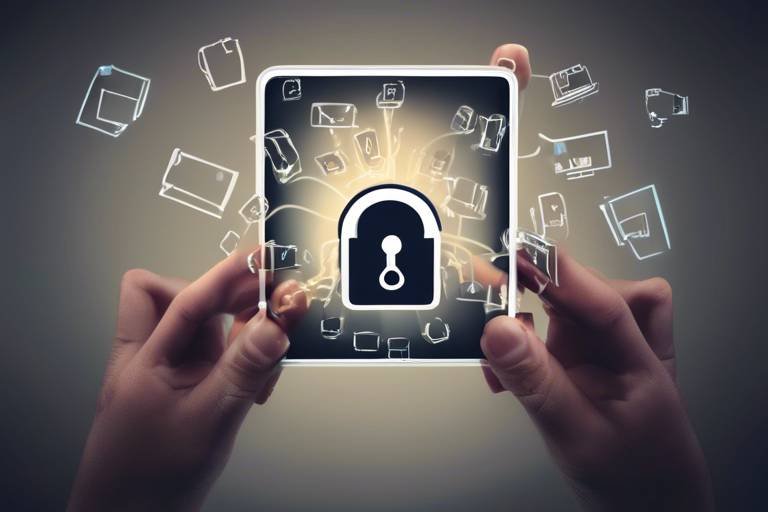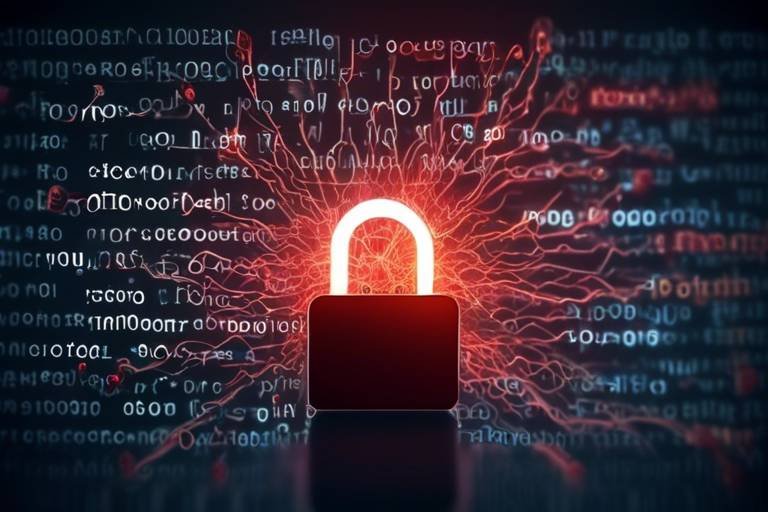Balancing Cybersecurity and Convenience: A Challenge
In today's digital landscape, where everything from banking to socializing occurs online, the importance of cybersecurity cannot be overstated. However, as we navigate this interconnected world, we find ourselves at a crossroads: how do we secure our information without sacrificing convenience? This dilemma is akin to walking a tightrope; one misstep can lead to a fall, whether that be a data breach or an inconvenient user experience. As we delve deeper into this topic, we will explore the intricate balance between robust security measures and user-friendly practices, shedding light on the challenges faced by both individuals and organizations.
Understanding why cybersecurity is crucial in today's interconnected world helps highlight the potential risks and threats that individuals and organizations face, emphasizing the need for effective protective measures. With the rise of cyber threats such as data breaches, identity theft, and ransomware attacks, the stakes have never been higher. For instance, according to a recent report, over 4,000 ransomware attacks occur daily, targeting businesses and individuals alike. This alarming statistic underscores the necessity of implementing strong cybersecurity protocols. Without them, we risk not only our personal information but also our financial stability and even our reputations.
Examining the inherent trade-offs between convenience and security reveals how users often compromise safety for ease of use. Picture this: you’re trying to log into your bank account, and you’re faced with a complex password requirement that seems more like a puzzle than a security measure. Frustrated, you might be tempted to use a simple password that you can easily remember, but this decision opens the door to vulnerabilities that can be exploited by cybercriminals. The reality is that many users prioritize convenience over security, leading to dangerous habits that put their sensitive information at risk. It’s a classic case of short-term gain for long-term pain.
User behavior plays a significant role in cybersecurity; understanding how habits and attitudes affect security practices can help in designing better protective measures and user-friendly solutions. For example, did you know that nearly 80% of data breaches are caused by weak or stolen passwords? This statistic highlights the crucial need for users to be educated about the importance of strong passwords and secure practices. By fostering a culture of security awareness, organizations can mitigate risks and empower users to take charge of their digital safety.
Phishing attacks are one of the most common threats in the digital age. These deceptive tactics prey on unsuspecting users, often appearing as legitimate requests for sensitive information. Increasing user awareness can significantly reduce the risk of falling victim to these scams. For instance, organizations can implement regular training sessions to educate employees about how to identify phishing emails. This proactive approach not only protects sensitive information but also fosters a more security-conscious workplace.
Implementing strong password practices is essential for enhancing security, yet many users find complex password requirements inconvenient and challenging to manage. It’s like trying to remember the lyrics to a song you just heard once—difficult and frustrating! To combat this, users can utilize password managers, which store and encrypt passwords securely. This way, they can enjoy the benefits of strong, unique passwords without the hassle of remembering each one. The key is to find a balance that works for both security and convenience.
Technological advancements offer innovative solutions that aim to strike a balance between cybersecurity and convenience. Tools such as multi-factor authentication (MFA) provide an added layer of security while still being user-friendly. Imagine logging into your account and receiving a text message with a verification code. It’s an extra step, yes, but one that significantly enhances your security without making the process overly cumbersome. As technology continues to evolve, we can expect even more solutions designed to enhance security without compromising user experience.
Organizations must navigate complex regulations regarding cybersecurity, balancing compliance requirements with the need to maintain user-friendly systems that do not hinder productivity. Regulations such as the General Data Protection Regulation (GDPR) set stringent data protection standards, compelling businesses to adopt practices that safeguard user information while ensuring a seamless user experience. Striking this balance can be challenging, as organizations must ensure that their systems comply with regulations without overwhelming users with cumbersome processes.
The General Data Protection Regulation (GDPR) sets stringent data protection standards, compelling businesses to adopt practices that safeguard user information while ensuring a seamless user experience. Compliance with GDPR not only protects users but also builds trust between organizations and their customers. However, the challenge lies in implementing these regulations without creating a labyrinth of processes that frustrate users. Organizations must find innovative ways to integrate compliance into their systems without sacrificing usability.
As technology evolves, emerging trends in cybersecurity will shape the landscape, influencing how organizations approach the challenge of balancing security and convenience in the years to come. For instance, the rise of artificial intelligence (AI) in cybersecurity offers promising solutions for detecting threats in real-time while minimizing user friction. Similarly, the increasing adoption of biometric authentication methods, such as fingerprint or facial recognition, provides a seamless yet secure way for users to access their accounts. The future of cybersecurity will likely revolve around leveraging technology to enhance security without compromising user experience.
- What is the biggest challenge in balancing cybersecurity and convenience? The biggest challenge is often user behavior; users may prioritize convenience over security, leading to risky practices.
- How can organizations improve user awareness of cybersecurity? Regular training and clear communication about security practices can significantly enhance user awareness.
- What role does technology play in improving cybersecurity? Technology offers innovative solutions, such as multi-factor authentication and AI-driven threat detection, that enhance security while maintaining user convenience.

The Importance of Cybersecurity
In today's hyper-connected world, the significance of cybersecurity cannot be overstated. Every day, individuals and organizations alike are exposed to a myriad of potential threats that can compromise sensitive information and disrupt operations. With the rise of the Internet of Things (IoT), cloud computing, and remote work, the digital landscape has become a playground for cybercriminals. It's like leaving the front door wide open; you might not think anything will happen, but the risks are all too real.
Cybersecurity is essential for protecting not just personal data, but also the integrity of entire organizations. A single breach can lead to devastating consequences, including financial losses, reputational damage, and legal ramifications. Consider this: a recent study found that the average cost of a data breach is approximately $3.86 million. That's a staggering figure that highlights why investing in robust cybersecurity measures is not just a luxury—it's a necessity.
Moreover, the importance of cybersecurity extends beyond just financial implications. It also encompasses the trust that customers place in businesses. When users share their data, they expect it to be safeguarded. If a company fails to protect that information, it risks losing not only money but also the confidence of its clientele. This trust is the lifeblood of any business; once it’s lost, it can be incredibly challenging to regain.
To better understand the threats we face, let’s consider some of the most common cybersecurity risks:
- Malware: Malicious software designed to harm or exploit devices, networks, or servers.
- Ransomware: A form of malware that encrypts files and demands payment for their release.
- Data Breaches: Unauthorized access to sensitive data, often leading to identity theft.
- Phishing: Deceptive attempts to obtain sensitive information by masquerading as a trustworthy entity.
As we navigate this digital era, it's crucial to implement effective protective measures. This includes not only investing in advanced security technologies but also fostering a culture of cybersecurity awareness among employees and users. Regular training sessions, updates on the latest threats, and clear communication about security policies can go a long way in building a resilient defense.
In summary, the importance of cybersecurity is paramount. It serves as a shield against a wide array of threats that can jeopardize personal and organizational safety. By prioritizing cybersecurity, we not only protect our data but also uphold the trust that is essential for thriving in the digital age.

Convenience vs. Security Trade-offs
In our fast-paced digital world, the trade-off between convenience and security is a conversation that is more relevant than ever. Imagine you’re at a coffee shop, trying to connect to the Wi-Fi. You want it to be quick and easy, but the moment you log on, you’re suddenly exposed to a myriad of potential threats. This scenario encapsulates the dilemma many of us face daily: how do we make our online experiences seamless without sacrificing our safety?
Users often find themselves in a tug-of-war between user-friendliness and the need for robust security measures. For instance, consider the typical scenario of creating an account on a new website. Many users breeze through the registration process, opting for simple passwords or even using the same password across multiple sites for the sake of convenience. This behavior, while understandable, opens the door to vulnerabilities that cybercriminals eagerly exploit.
Furthermore, organizations are not exempt from this struggle. In their quest to provide a smooth user experience, businesses sometimes relax their security protocols, leading to potential breaches. For example, a company might choose to implement a single sign-on (SSO) feature to simplify access for users. While this enhances convenience, it can also create a single point of failure, making it easier for attackers to gain unauthorized access.
To illustrate this point further, let’s break down some common areas where convenience often trumps security:
- Weak Password Practices: Users often prefer simple passwords that are easy to remember, but these are also easy for hackers to guess.
- Two-Factor Authentication (2FA): While 2FA significantly enhances security, many users find the extra step cumbersome and often skip it.
- Software Updates: Regular updates are crucial for security, yet users frequently postpone them for the sake of convenience.
In essence, the allure of convenience can lead users down a precarious path. The challenge lies in educating users about the importance of maintaining security without making them feel overwhelmed. It’s crucial to design systems that are both secure and user-friendly. This means creating interfaces that guide users toward better security practices without making them feel burdened.
As we navigate this complex landscape, it’s clear that finding the right balance is not just a technical challenge; it’s a human one. It requires understanding user behavior and preferences, and then tailoring security measures that feel less like a chore and more like a natural part of the online experience. After all, when users feel empowered rather than restricted, they are more likely to adopt security practices that protect both themselves and the organizations they interact with.

User Behavior and Cybersecurity
User behavior is a pivotal factor in the realm of cybersecurity. It’s fascinating how our everyday actions, often taken for granted, can either fortify or undermine our digital defenses. Just think about it: we live in a world where a single click can lead to a cascade of events, potentially exposing sensitive information to cybercriminals. The way we interact with technology—our habits, our knowledge, and even our attitudes—plays a crucial role in shaping the security landscape. This is where the challenge lies: how do we cultivate a culture of security awareness without making users feel overwhelmed or burdened?
Imagine a bustling city where every street corner is monitored by security cameras. While this might enhance safety, it could also feel invasive to the residents. Similarly, in the digital world, users often grapple with the tension between wanting to feel secure and the desire to maintain their freedom and convenience. Many individuals underestimate the importance of their actions, believing that cybersecurity is solely the responsibility of IT departments or software solutions. However, it’s essential to recognize that each user is a critical line of defense against potential threats.
To illustrate this point, consider the following common user behaviors that can impact cybersecurity:
- Sharing Passwords: Many users share their passwords with friends or family, thinking it’s harmless. This practice can significantly increase vulnerability.
- Ignoring Software Updates: Regular updates often contain vital security patches. Neglecting them can leave systems exposed to known vulnerabilities.
- Weak Password Choices: The tendency to use easily guessable passwords, like "123456" or "password," can make accounts an easy target for hackers.
By understanding these behaviors, organizations can tailor their training and awareness programs to address specific user tendencies. For instance, implementing engaging training sessions that simulate phishing attempts can help users recognize suspicious emails. Additionally, organizations can introduce gamified learning experiences that make security training fun and interactive, thus fostering a more security-conscious culture.
Furthermore, organizations should consider the psychology behind user behavior when designing security protocols. For instance, if a system prompts users to create complex passwords, the process should be accompanied by clear guidelines and tools, such as password managers, to ease the burden. By doing so, organizations can encourage users to adopt safer practices without feeling overwhelmed.
Ultimately, enhancing cybersecurity is a collective effort. It requires a shift in mindset where users see themselves as active participants in their own digital safety. Just like wearing a seatbelt while driving, practicing good cybersecurity habits should become second nature. By fostering an environment of awareness and responsibility, we can significantly mitigate risks and create a safer digital space for everyone.
Q: How can I improve my cybersecurity awareness?
A: Start by educating yourself on common threats like phishing and malware. Participate in training sessions offered by your organization and stay updated on the latest security practices.
Q: What are some simple steps I can take to enhance my online security?
A: Use strong, unique passwords for different accounts, enable two-factor authentication, and regularly update your software to protect against vulnerabilities.
Q: Why is user behavior critical in cybersecurity?
A: User behavior directly influences the effectiveness of security measures. Informed and vigilant users can act as a robust defense against cyber threats.

Phishing Attacks and User Awareness
In the vast ocean of the internet, phishing attacks are like cunning predators lurking beneath the surface, ready to ensnare unsuspecting users. These attacks often take the form of seemingly legitimate emails or messages that trick individuals into revealing sensitive information, such as passwords or credit card numbers. The sad truth is that the success of these scams largely hinges on a lack of user awareness. When individuals are not adequately informed about the tactics employed by cybercriminals, they become easy targets. So, how do we combat this ever-evolving threat?
First and foremost, education is key. Organizations and individuals alike must prioritize training sessions that focus on recognizing phishing attempts. This includes understanding the common signs of phishing emails, such as:
- Unfamiliar sender addresses
- Urgent language demanding immediate action
- Links that lead to suspicious websites
- Attachments that could contain malware
Moreover, fostering a culture of skepticism can significantly bolster defenses against these attacks. Encourage users to ask questions like, "Is this email from a trusted source?" or "Does this request seem unusual?" By promoting a mindset of caution, users become less likely to fall prey to these deceptive tactics. It's akin to teaching someone to be wary of strangers offering candy; the more they know, the less likely they are to be lured in.
Additionally, integrating multi-factor authentication (MFA) can serve as a formidable barrier against phishing attempts. Even if a user inadvertently provides their password, MFA requires an additional verification step, making it significantly harder for attackers to gain unauthorized access. This layered approach to security not only protects sensitive information but also instills a sense of confidence in users as they navigate the digital landscape.
In conclusion, while phishing attacks pose a serious threat, user awareness can act as a powerful shield. By educating individuals about the signs of phishing and promoting cautious behavior, we can create a more secure online environment. Remember, in the battle against cyber threats, knowledge is not just power; it’s your best defense.
Here are some common questions regarding phishing attacks and user awareness:
- What is a phishing attack? A phishing attack is a fraudulent attempt to obtain sensitive information from users by disguising as a trustworthy entity.
- How can I identify a phishing email? Look for unfamiliar sender addresses, urgent requests, suspicious links, and unexpected attachments.
- What should I do if I suspect a phishing attempt? Do not click on any links or provide information. Report the email to your organization's IT department or the relevant authorities.
- How can multi-factor authentication help? MFA adds an extra layer of security, requiring additional verification beyond just a password, making unauthorized access more difficult.

Strong Password Practices
In today’s digital landscape, where cyber threats lurk around every corner, implementing is not just a good idea—it’s essential. Think of your password as the key to your digital fortress. If that key is weak or easily duplicated, it’s only a matter of time before intruders gain access to your most sensitive information. But let’s face it: creating and remembering complex passwords can feel like a chore. Many users find themselves caught in a tug-of-war between the need for security and the desire for convenience.
So, what makes a password strong? A robust password typically includes a mix of uppercase and lowercase letters, numbers, and special characters. For instance, instead of using a simple word like "password," try something more complex like "P@ssw0rd!2023". This not only makes it harder for hackers to crack but also adds a layer of security that is often overlooked. However, with our busy lives, remembering such intricate combinations can be a challenge. This is where password managers come into play. These handy tools can generate, store, and autofill your passwords, allowing you to maintain strong security without the headache of memorization.
Another critical aspect of strong password practices is the use of unique passwords for different accounts. Imagine using the same key for your home, car, and office. If someone manages to duplicate that key, you’d be in serious trouble! Similarly, if you use the same password across multiple sites, a breach on one platform can lead to a domino effect, compromising your other accounts. According to a recent study, over 80% of data breaches are due to weak or stolen passwords. This statistic underscores the importance of treating each password as a unique entity.
Moreover, it’s essential to change your passwords regularly. Set a reminder to update them every three to six months. This habit can significantly reduce the risk of unauthorized access. If you suspect any suspicious activity on your account, change your password immediately. Remember, in the world of cybersecurity, proactivity is key.
In conclusion, while strong password practices may seem tedious, they are vital for protecting your digital life. The balance between convenience and security can be achieved by leveraging technology, such as password managers, and adopting good habits like using unique passwords and changing them regularly. By taking these steps, you can ensure that your fortress remains secure against the ever-evolving threats in the digital realm.
- What is a strong password? A strong password typically includes a mix of uppercase and lowercase letters, numbers, and special characters, making it difficult to guess or crack.
- How often should I change my password? It is recommended to change your passwords every three to six months or immediately if you suspect any suspicious activity.
- Are password managers safe? Yes, reputable password managers use strong encryption to protect your data, making them a safe option for managing your passwords.
- What should I do if I forget my password? Most websites offer a password recovery option. Make sure to set up recovery options, such as security questions or backup email addresses, to regain access.

Technological Solutions for Balance
In today’s fast-paced digital landscape, finding the right technological solutions that harmonize cybersecurity and user convenience is more crucial than ever. As cyber threats evolve, so do the methods we use to protect ourselves. Companies and individuals alike are turning to innovative technologies to create a safer online environment without sacrificing usability. Imagine trying to walk a tightrope; on one side, you have the need for robust security, while on the other, there’s the desire for seamless user experience. The key lies in finding that sweet spot in the middle.
One of the most promising solutions is the implementation of multi-factor authentication (MFA). This method adds an extra layer of security by requiring users to provide two or more verification factors to gain access to their accounts. Think of it as a double lock on your front door; it might take a little more time to unlock, but it significantly reduces the risk of unauthorized entry. By using something you know (like a password) along with something you have (like a smartphone), organizations can greatly enhance their security posture without making it overly cumbersome for users.
Another exciting development is the use of biometric authentication. This technology leverages unique physical characteristics—such as fingerprints, facial recognition, or even iris scans—to verify identity. Biometric systems are not only user-friendly but also provide a level of security that traditional passwords simply can’t match. Imagine walking up to your device, and with just a glance or a touch, you’re granted access. It’s quick, efficient, and remarkably secure.
Artificial Intelligence (AI) is also playing a pivotal role in striking this balance. AI-driven security solutions can analyze user behavior in real-time, identifying anomalies that may indicate a security threat. For instance, if a user typically logs in from New York but suddenly attempts to access their account from another continent, AI can flag this behavior for further investigation. This proactive approach allows organizations to respond to potential threats swiftly, often before any damage can occur.
Additionally, cloud security solutions offer flexible, scalable options that can adapt to the needs of both large organizations and individual users. With cloud services, sensitive data can be stored securely and accessed easily, ensuring that users can work from anywhere without compromising their security. However, it’s essential to choose reputable cloud providers that prioritize data protection and comply with regulatory standards.
To better illustrate these technological solutions, consider the following table that outlines various approaches and their benefits:
| Technology | Benefits |
|---|---|
| Multi-Factor Authentication | Enhanced security with minimal user inconvenience. |
| Biometric Authentication | Fast and secure access using unique physical traits. |
| Artificial Intelligence | Real-time threat detection and response. |
| Cloud Security Solutions | Flexible, scalable security for remote access. |
Ultimately, the goal is to create a cybersecurity environment that doesn’t feel like a burden. By leveraging these technological advancements, organizations can significantly improve their security measures while ensuring that users enjoy a smooth and efficient experience. In a world where everything is interconnected, the challenge is not just to protect data but to do so in a way that feels natural and intuitive to the user. As we continue to innovate, the balance between cybersecurity and convenience will become increasingly attainable.
- What is multi-factor authentication?
Multi-factor authentication (MFA) is a security measure that requires users to provide two or more verification factors to access their accounts. - How does biometric authentication work?
Biometric authentication uses unique physical characteristics, such as fingerprints or facial recognition, to verify a user's identity. - What role does AI play in cybersecurity?
AI helps in analyzing user behavior and identifying anomalies that may indicate security threats, allowing for proactive responses. - Are cloud security solutions safe?
Yes, cloud security solutions can be safe if you choose reputable providers that prioritize data protection and comply with regulations.

Regulatory Compliance and Challenges
In the digital landscape, navigating the waters of regulatory compliance can feel like steering a ship through a storm. Organizations are not just tasked with protecting their data; they must also adhere to a plethora of laws and regulations that govern how that data is managed. This balancing act is crucial because failing to comply can lead to hefty fines, legal troubles, and a tarnished reputation. The challenge lies in ensuring that compliance measures do not compromise user experience or productivity.
One of the most significant regulations in recent years is the General Data Protection Regulation (GDPR), which came into effect in May 2018. GDPR sets a high standard for data protection, requiring organizations to implement stringent measures to safeguard user information. But what does this mean for businesses? Essentially, they must ensure that any personal data they collect is processed legally, transparently, and fairly. This involves obtaining explicit consent from users and providing them with the right to access, rectify, and delete their data.
However, the implementation of such regulations can often create friction between compliance and user convenience. For instance, while GDPR mandates that users must be informed about how their data is used, this can lead to lengthy consent forms that deter users from engaging with a service. Organizations must find ways to streamline this process without sacrificing compliance. This is where technology plays a pivotal role, offering innovative solutions that can simplify the user experience while ensuring adherence to regulatory standards.
Moreover, the landscape of regulatory compliance is continually evolving. Organizations need to stay updated with changes in laws and regulations, which can be a daunting task. The following table outlines some of the key regulations that organizations must consider:
| Regulation | Key Focus | Compliance Challenges |
|---|---|---|
| GDPR | Data protection and privacy | Obtaining user consent, data processing transparency |
| HIPAA | Healthcare data protection | Ensuring patient confidentiality, secure data handling |
| CCPA | Consumer privacy rights | Providing opt-out options, data access requests |
As organizations strive to comply with these regulations, they often face several challenges:
- Resource Allocation: Allocating sufficient resources—both financial and human—towards compliance efforts can strain smaller organizations.
- Employee Training: Ensuring that all employees understand compliance requirements and the importance of data protection is essential yet challenging.
- Technological Integration: Implementing new technologies to meet compliance standards without disrupting existing operations can be complex.
In conclusion, while regulatory compliance is a necessary part of operating in today’s digital environment, it presents unique challenges that organizations must navigate carefully. Striking a balance between compliance and user convenience is not just about adhering to the law; it’s about fostering trust and ensuring that users feel safe and valued. As we move forward, organizations that embrace innovative solutions and prioritize user experience will undoubtedly have an edge in this constantly evolving landscape.
- What is GDPR? GDPR stands for General Data Protection Regulation, a regulation in EU law on data protection and privacy.
- Why is regulatory compliance important? It helps protect user data, fosters trust, and avoids legal penalties.
- How can organizations balance compliance and user experience? By leveraging technology, streamlining processes, and prioritizing user-friendly practices.
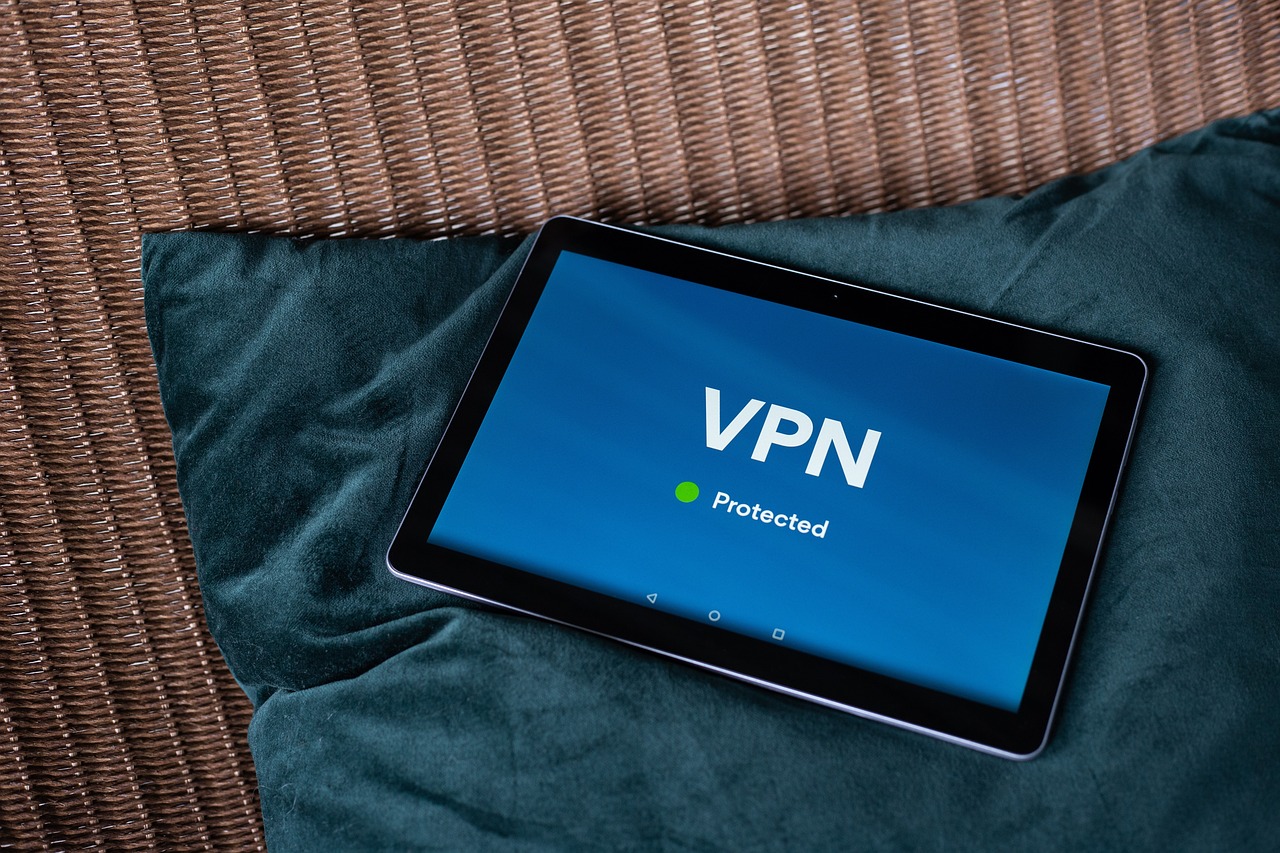
GDPR and Data Protection
The General Data Protection Regulation (GDPR) has revolutionized how organizations handle personal data within the European Union. Introduced in May 2018, this regulation aims to protect the privacy of individuals while ensuring that their data is processed transparently and securely. But what does this mean for businesses and consumers alike? In a world where data breaches are all too common, the GDPR serves as a beacon of hope, establishing stringent guidelines that compel organizations to prioritize user privacy.
At its core, the GDPR emphasizes the importance of obtaining explicit consent from users before collecting or processing their personal data. This means that organizations must clearly inform individuals about why their data is being collected, how it will be used, and how long it will be retained. Imagine walking into a store where every item is tagged with a clear description and price—this is the level of transparency that the GDPR seeks to achieve in the digital realm.
Moreover, the GDPR grants individuals several rights concerning their personal data, including:
- The Right to Access: Individuals can request access to their personal data and inquire how it is being used.
- The Right to Rectification: Users can correct inaccurate or incomplete data.
- The Right to Erasure: Also known as the "right to be forgotten," individuals can request the deletion of their data under certain circumstances.
- The Right to Data Portability: Users can obtain their data in a structured, commonly used format and transfer it to another service provider.
This regulation not only enhances user trust but also compels organizations to adopt robust data protection measures. However, navigating the complexities of GDPR compliance can be a challenge for many businesses. They must implement policies and technologies that not only secure data but also ensure that users can easily exercise their rights. Think of it like a tightrope walk—organizations must find a way to balance compliance with user-friendly practices to avoid falling into the pitfalls of bureaucracy.
To illustrate the impact of GDPR, consider the following table that outlines key requirements and their implications for organizations:
| Requirement | Description | Implication for Organizations |
|---|---|---|
| Data Protection Officer (DPO) | Organizations must appoint a DPO if they handle large amounts of personal data. | Increased accountability and oversight in data handling practices. |
| Data Breach Notification | Organizations must notify authorities and affected individuals within 72 hours of a data breach. | Prompt action is required, which can strain resources and impact reputation. |
| Privacy by Design | Data protection must be integrated into the development of business processes and technologies. | Encourages proactive measures rather than reactive fixes. |
As we delve deeper into the implications of GDPR, it becomes clear that while the regulation poses challenges, it also presents opportunities for organizations to build trust with their customers. By prioritizing data protection, businesses can differentiate themselves in a crowded market, appealing to consumers who are increasingly concerned about their privacy. In essence, GDPR isn’t just a set of rules; it’s a chance for companies to foster a culture of respect and transparency.
In conclusion, the GDPR has undoubtedly reshaped the landscape of data protection, pushing organizations to rethink their approach to user privacy. As we move forward, it will be fascinating to see how businesses adapt to these regulations while still delivering a seamless user experience. Striking the right balance between compliance and convenience will be the key to thriving in this new era of data protection.
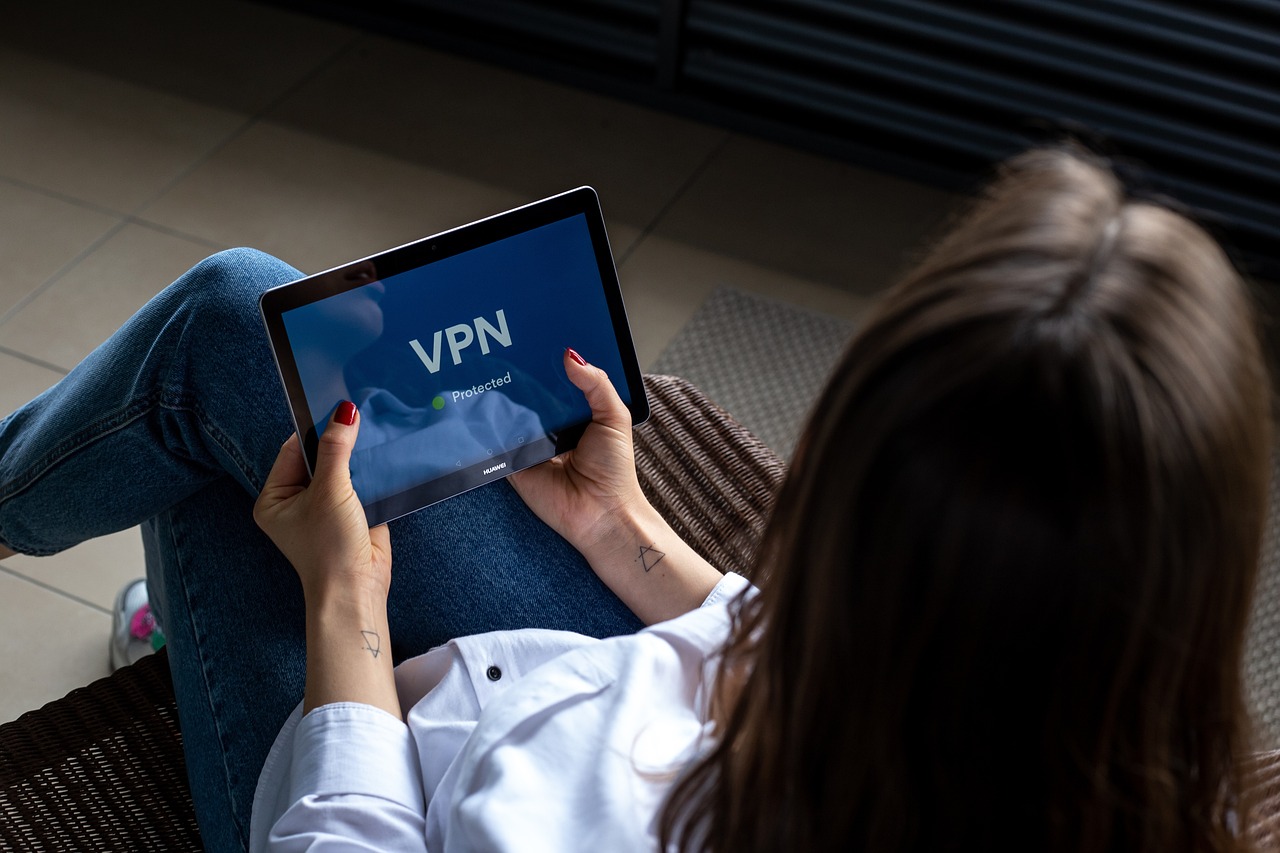
Future Trends in Cybersecurity
As we look to the horizon, the realm of cybersecurity is evolving at a breakneck pace, driven by rapid technological advancements and the ever-changing landscape of cyber threats. It's a bit like riding a roller coaster – thrilling yet nerve-wracking! The future of cybersecurity is not just about tightening defenses; it’s about adapting to new realities that blend innovation with protection.
One of the most significant trends is the rise of **artificial intelligence (AI)** and **machine learning** in cybersecurity. These technologies are transforming the way organizations detect and respond to threats. Imagine having a virtual security guard that learns from every incident, becoming smarter and more efficient over time. AI can analyze vast amounts of data in real-time, identifying anomalies and potential threats faster than any human could. This shift is akin to having a digital Sherlock Holmes on your team, constantly scanning for clues that might indicate a breach.
However, with great power comes great responsibility. The use of AI also introduces new vulnerabilities. Cybercriminals are beginning to leverage AI for their nefarious purposes, creating sophisticated attacks that can bypass traditional security measures. Therefore, it’s crucial for organizations to stay one step ahead, continuously updating their defenses and employing AI in a way that enhances security without compromising user experience.
Another trend gaining traction is the **adoption of zero-trust security models**. The traditional approach of trusting users inside the network perimeter is becoming outdated. Instead, zero trust operates on the principle of “never trust, always verify.” This means that every user and device, regardless of location, must be authenticated and authorized before accessing sensitive information. Think of it as a club with a bouncer who checks IDs at every entrance, ensuring only the right people get in. This method significantly reduces the risk of insider threats and data breaches.
Furthermore, the **Internet of Things (IoT)** is expanding rapidly, and with it, the need for robust security measures. As more devices connect to the internet, they become potential entry points for cyberattacks. According to recent statistics, the number of IoT devices is expected to reach **30 billion by 2025**. This explosion of connectivity necessitates a comprehensive approach to security that encompasses not just traditional IT assets but also a myriad of connected devices. Organizations must prioritize securing these devices, ensuring that they do not become weak links in the security chain.
On the regulatory front, compliance will continue to play a pivotal role in shaping cybersecurity practices. As governments worldwide enact stricter regulations to protect consumer data, organizations will need to invest more in compliance-related technologies. This is not just about avoiding fines; it’s about building trust with customers. A transparent approach to data protection can be a powerful differentiator in a crowded marketplace.
Lastly, the human element in cybersecurity cannot be overlooked. As technology advances, so too must our focus on **user education and awareness**. Cybersecurity is not solely the responsibility of IT departments; it’s a collective effort that involves everyone in an organization. Regular training sessions, phishing simulations, and awareness campaigns can empower employees to recognize and respond to threats effectively. After all, even the most advanced security systems can falter if users are not vigilant.
In conclusion, the future of cybersecurity is a blend of innovation, responsibility, and collaboration. As we embrace new technologies and methodologies, it’s essential to maintain a focus on securing our digital landscape while ensuring that user experience remains a priority. The journey may be challenging, but with the right strategies in place, we can navigate the complexities of cybersecurity effectively.
- What is the zero-trust security model? The zero-trust model is a cybersecurity approach that requires strict verification for every user and device attempting to access resources, regardless of whether they are inside or outside the network perimeter.
- How does AI improve cybersecurity? AI enhances cybersecurity by analyzing large volumes of data to detect anomalies and potential threats in real-time, allowing for quicker responses to incidents.
- Why is user education important in cybersecurity? User education is crucial because human error is often a significant factor in security breaches. Educated users are better equipped to recognize and respond to threats.
- What are some common IoT security risks? Common risks include weak passwords, lack of updates, and unsecured devices, which can serve as entry points for cyberattacks.
Frequently Asked Questions
- What is the importance of cybersecurity in today's digital world?
Cybersecurity is crucial because it protects sensitive information from cyber threats. In a world where we rely heavily on technology, the risks of data breaches, identity theft, and cyberattacks are ever-present. Effective cybersecurity measures help safeguard personal and organizational data, ensuring privacy and trust in digital transactions.
- How do convenience and security trade-offs affect users?
Users often face a dilemma between convenience and security. For instance, while a simple password may be easier to remember, it can also be easier for hackers to guess. This trade-off can lead to vulnerabilities, as users might prioritize ease of access over robust security measures, making them targets for cybercriminals.
- What role does user behavior play in cybersecurity?
User behavior significantly impacts cybersecurity. Habits like reusing passwords or clicking on suspicious links can create vulnerabilities. By understanding these behaviors, organizations can design better security practices and user-friendly solutions that encourage safer online habits.
- How can I protect myself from phishing attacks?
To protect yourself from phishing attacks, always verify the sender's email address before clicking on links or downloading attachments. Be cautious of unsolicited messages requesting personal information. Additionally, educating yourself about common phishing tactics can significantly reduce your risk of falling victim to these scams.
- What are strong password practices?
Strong password practices include using a mix of uppercase and lowercase letters, numbers, and special characters. It's advisable to create long passwords (at least 12 characters) and avoid easily guessable information like birthdays. Using a password manager can also help you manage complex passwords without the hassle of remembering them all.
- How can technology help balance cybersecurity and convenience?
Technological advancements, such as biometric authentication (like fingerprint or facial recognition) and single sign-on solutions, can enhance security while simplifying the user experience. These tools allow users to access their accounts securely without needing to remember multiple complex passwords.
- What are the regulatory challenges organizations face regarding cybersecurity?
Organizations must navigate complex regulations like GDPR, which impose strict data protection standards. Balancing compliance with user-friendly systems can be challenging, as businesses need to ensure they meet legal requirements while maintaining productivity and user satisfaction.
- How does GDPR impact data protection practices?
GDPR compels organizations to adopt stringent data protection practices, ensuring user information is safeguarded. It requires businesses to implement measures that not only protect data but also provide users with clear information about how their data is used, enhancing transparency and trust.
- What future trends should we expect in cybersecurity?
As technology evolves, we can expect trends like increased use of artificial intelligence for threat detection, the rise of zero-trust security models, and greater focus on privacy-centric technologies. These trends will shape how organizations approach the challenge of balancing cybersecurity with user convenience in the coming years.





